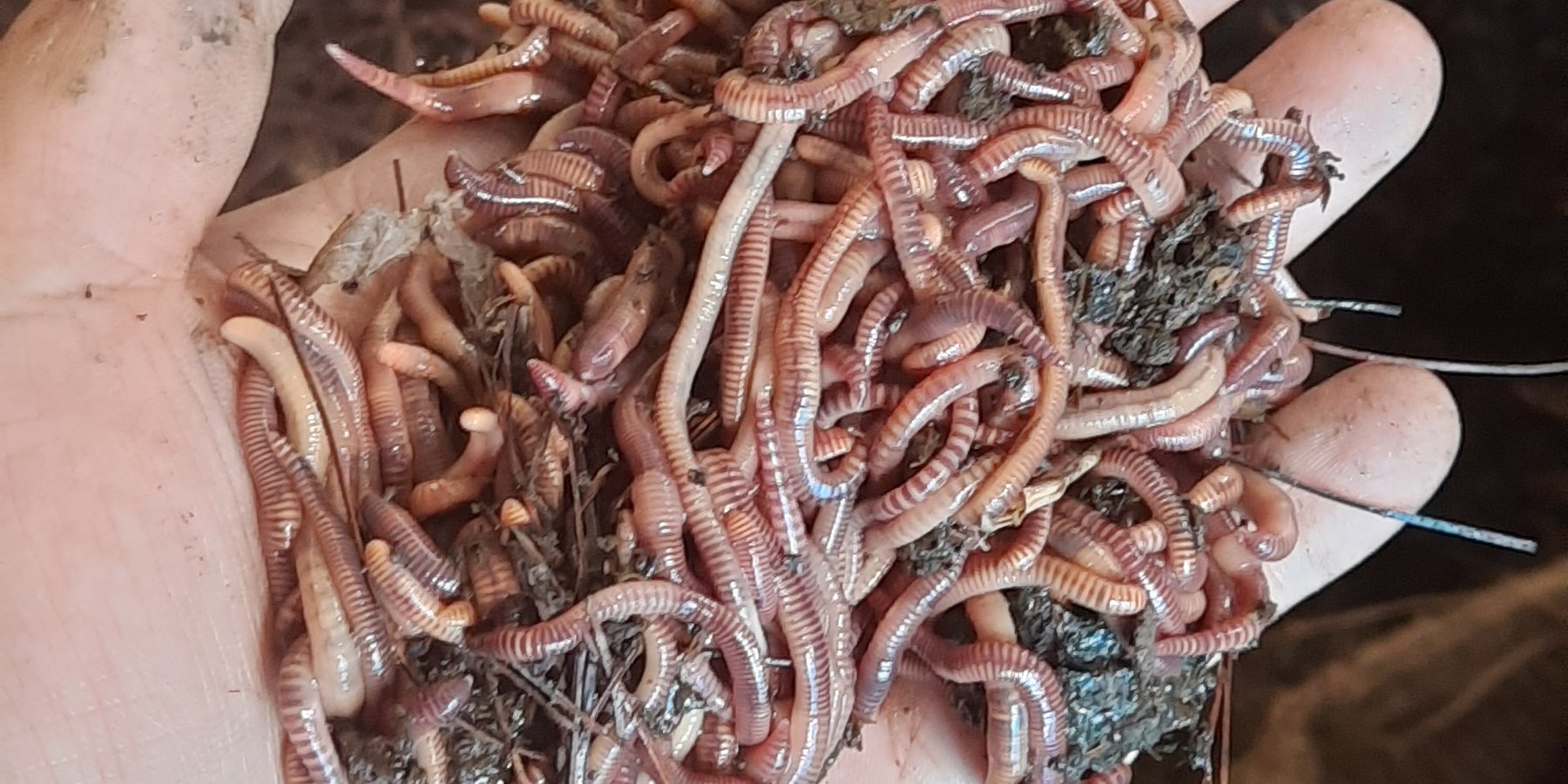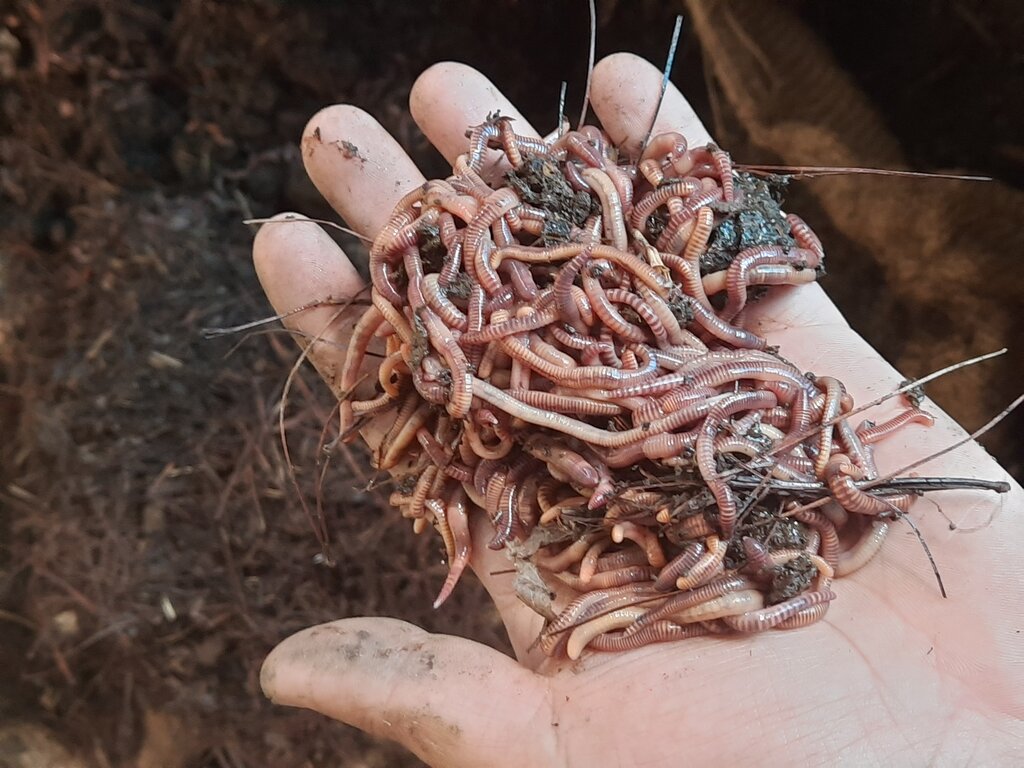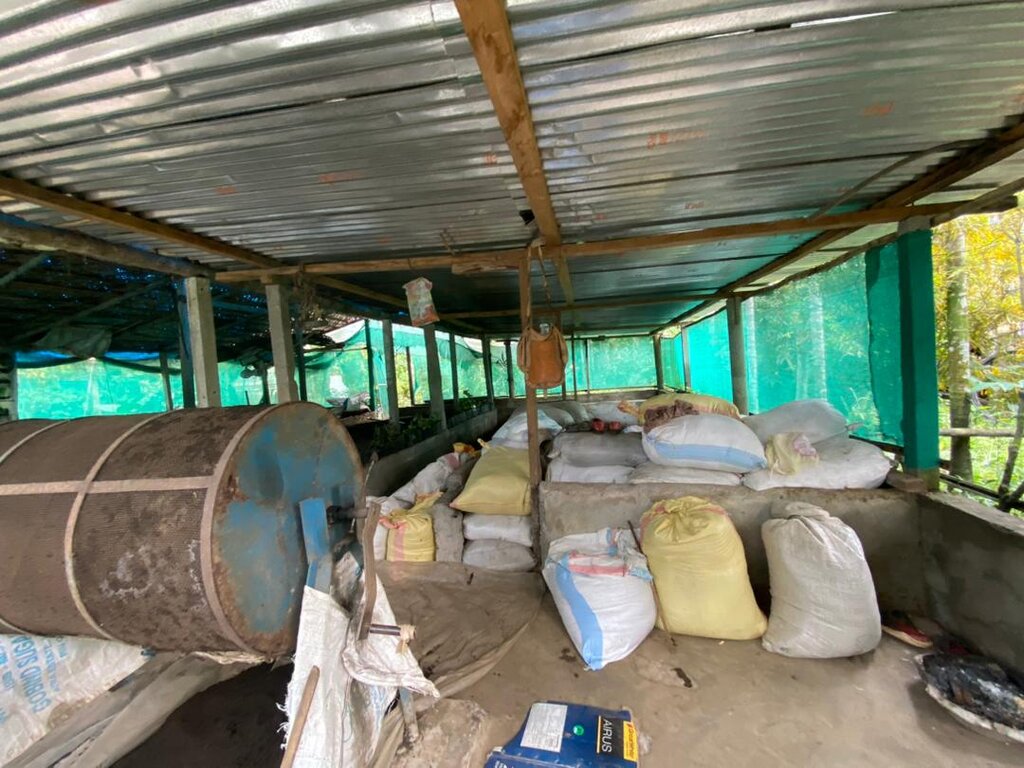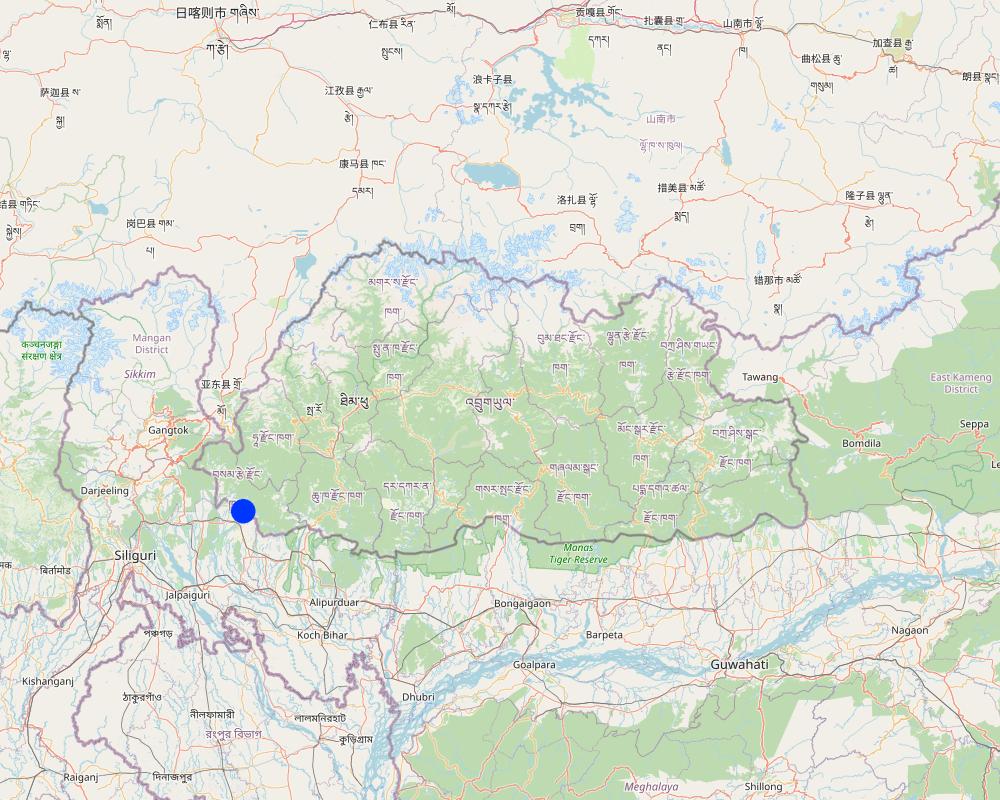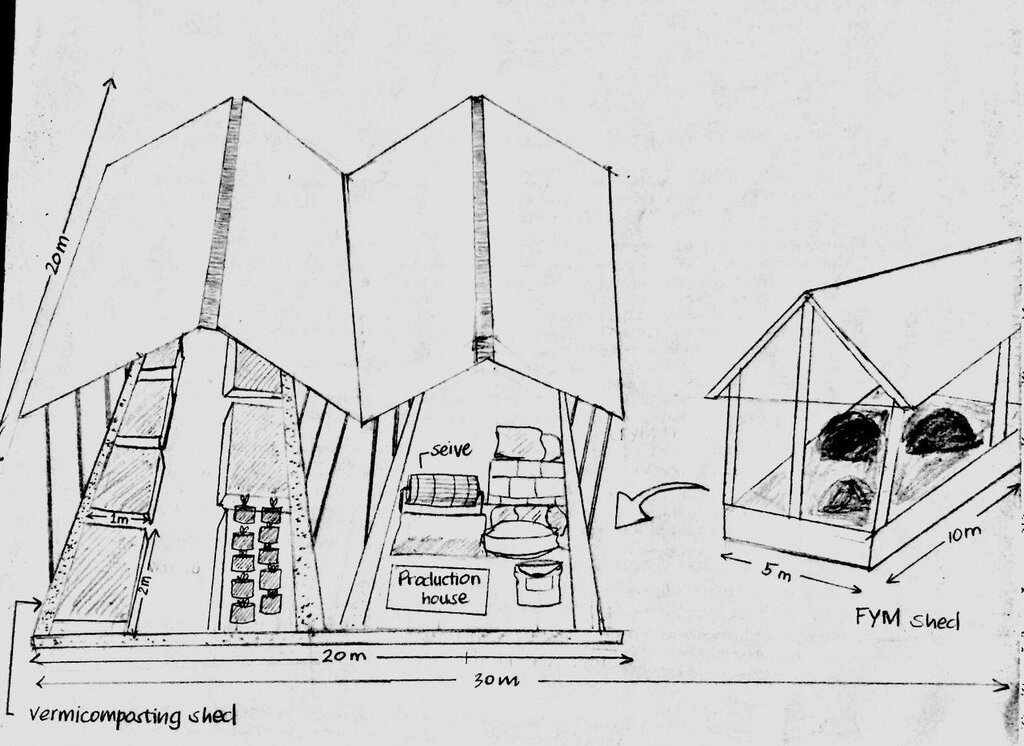Vermicomposting [不丹]
- 创建:
- 更新:
- 编制者: Karma Wangdi
- 编辑者: Kuenzang Nima
- 审查者: William Critchley, Rima Mekdaschi Studer, Joana Eichenberger
Chong Boob Gi Lue Zhoni (ལྕོང་འབུཔ་ཀྱི་ལུད་བཟོ་ནི།)
technologies_6874 - 不丹
查看章节
全部展开 全部收起1. 一般信息
1.2 参与该技术评估和文件编制的资源人员和机构的联系方式
关键资源人
土地使用者:
Gurung Divya
Norbugang
不丹
有助于对技术进行记录/评估的项目名称(如相关)
Strengthening national-level institutional and professional capacities of country Parties towards enhanced UNCCD monitoring and reporting – GEF 7 EA Umbrella II (GEF 7 UNCCD Enabling Activities_Umbrella II)1.3 关于使用通过WOCAT记录的数据的条件
编制者和关键资源人员接受有关使用通过WOCAT记录数据的条件。:
是
1.4 所述技术的可持续性声明
这里所描述的技术在土地退化方面是否存在问题,导致无法被认为是一种可持续的土地管理技术?:
否
注释:
This technology does not pose any land degradation problems
2. SLM技术的说明
2.1 技术简介
技术定义:
Vermicomposting is the practice of composting organic waste products with the aid of various types of worms. These worms aid the decomposition of organic materials, including kitchen leftovers and yard trash, resulting in the production of compost that is abundant in nutrients.
2.2 技术的详细说明
说明:
Vermicomposting is where organic wastes are broken down by redworms (Eisenia fetida or Lumbricus rubellus) and other types of earthworms. The worms produce nutrient-rich castings, which are valuable natural fertilizers for plants and enhance soil health. Vermicomposting is an effective and environmentally acceptable approach to recycle organic waste and produces a valuable resource for farming and gardening (Grant, 2021).
The raw substrate is initially ground in the gizzard to create smaller particles, increasing the surface area during the vermicomposting process. Earthworm gut microorganisms and digestive enzymes continue to work on the material to create a fine granular product that is rich in healthy nutrients and microbiota (Sharma & Garg, 2017). Vermicomposting is popular in urban gardening and horticulture, where space and resource constraints are common.
It is a sustainable and effective method for managing organic waste because it combines a number of essential traits and components. Firstly, it involves the usage of particular types of earthworms, such Eisenia fetida (red wigglers), which are renowned for their capacity to ingest enormous quantities of organic material. Maintaining optimum moisture levels, typically between 60 and 80 percent, is necessary for efficient vermicomposting. Another crucial component is aeration, which encourages aerobic decomposition and reduces odour. Vermicompost bins or beds are made with sufficient drainage and ventilation systems to do this. The ideal temperature range is between 15 o to 30 o C (Adhikary, 2012). Vermicomposting's goals and functions include waste reduction, improved soil fertility, soil restoration, sustainable agriculture, and easily accessible waste management.
Vermiculture encourages eco-friendly gardening and supports sustainable agriculture methods by limiting the use of chemical fertilizers. The initial expense and time needed to set up a vermicomposting system are two significant drawbacks. Another difficulty is the requirement for constant monitoring and upkeep, including controlling moisture levels, ensuring adequate aeration, and controlling temperature conditions. Poor environmental care can result in bad smells or even the death of earthworms.
Samtse's first and only vermicomposting facility in Norbugang gewog is performing successfully. The project, which began on a couple's farm near Bhimtar in December 2013, employs earthworms to convert organic waste into high-quality compost. It is the end result of the decomposition of organic elements by earthworms. The dzongkhag's assistant agricultural officer (ADAO) spearheaded the idea of establishing the compost plant, with assistance from the national organic program. The main substrate used for vermicomposting is cow dung and banana stems. The mixture is spread out as a bed inside the compost house for the earthworms to feed. The worms break down the mixture to produce vermicompost.
Initially, a kilogram of red earthworms (Eisenia foetida) were cultivated in a nursery. In a month, the nursery produced 10 kg, which was then employed in the project. According to Dibya Gurung, the worms needed 28 days to feed on the organic wastes in the existing compost house environment. Bhutanese farmers utilize vermicompost as a nutrient-rich organic fertilizer to enhance soil fertility and improve crop yields. This promote sustainable agriculture practices and reduce dependence on chemical fertilizers, aligning with Bhutan's goal of achieving food self-sufficiency.
There are currently 12 organic fertilizer producers in the Bhutan producing various types of compost, including vermi-compost, liquid fertilizer, bio-slurry compost, chicken manure, and EM solution. However, there is no record of a dedicated vermiculture enterprise in the nation, even though worms are required to make compost organic fertilizer, according to the National Soil Services Centre (NSSC), Department of Agriculture (DoA). For instance, the country generated 8130MT of organic fertilizers, according to the NSSC's annual report for 2021–2022 (Dorji, 2022).
2.3 技术照片
2.5 已应用该技术的、本评估所涵盖的国家/地区/地点
国家:
不丹
区域/州/省:
Samtse
有关地点的进一步说明:
Norbugang
具体说明该技术的分布:
- 适用于特定场所/集中在较小区域
技术现场是否位于永久保护区?:
否
Map
×2.6 实施日期
如果不知道确切的年份,请说明大概的日期:
- 不到10年前(最近)
2.7 技术介绍
详细说明该技术是如何引入的:
- 通过项目/外部干预
注释(项目类型等):
National Organic Flagship Program
3. SLM技术的分类
3.1 该技术的主要目的
- 改良生产
- 保护生态系统
- 保持/提高生物多样性
- 创造有益的经济影响
3.2 应用该技术的当前土地利用类型

农田
- Floriculture
采用间作制度了吗?:
是
如果是,说明哪些作物是间作的:
na
采用轮作制度了吗?:
否
注释:
Only floriculture is done
3.3 由于技术的实施,土地使用是否发生了变化?
由于技术的实施,土地使用是否发生了变化?:
- 否(继续问题3.4)
同一土地单元内混合使用的土地::
否
注释:
floriculture is done
3.4 供水
该技术所应用土地的供水:
- 充分灌溉
3.5 该技术所属的SLM组
- 土壤肥力综合管理
- 废物管理/废水管理
- 家庭花园
3.6 包含该技术的可持续土地管理措施

结构措施
- S8:卫生/废水结构物

管理措施
- M6:废物管理(回收、再利用或减少)
3.7 该技术强调的主要土地退化类型

其它
具体说明:
Improve soil fertility management
注释:
na
3.8 防止、减少或恢复土地退化
具体数量名该技术与土地退化有关的目标:
- 减少土地退化
- 修复/恢复严重退化的土地
4. 技术规范、实施活动、投入和成本
4.1 该技术的技术图纸
4.2 有关投入和成本计算的一般信息
具体说明成本和投入是如何计算的:
- 每个技术单元
其它/国家货币(具体说明):
Ngultrum
如相关,注明美元与当地货币的汇率(例如1美元=79.9巴西雷亚尔):1美元=:
250.0
注明雇用劳工的每日平均工资成本:
250
4.3 技术建立活动
| 活动 | 时间(季度) | |
|---|---|---|
| 1. | Site selection | winter |
| 2. | Collection of raw materials | winter |
| 3. | construction of vermicomposting shed | winter |
| 4. | construction of bricks lined beds for rearing earth worms | winter |
| 5. | Construction of FYM shed | winter |
4.4 技术建立所需要的费用和投入
| 对投入进行具体说明 | 单位 | 数量 | 单位成本 | 每项投入的总成本 | 土地使用者承担的成本% | |
|---|---|---|---|---|---|---|
| 劳动力 | labor | per head | 7.0 | 250.0 | 1750.0 | 50.0 |
| 植物材料 | Cow dung | Kg | 5000.0 | 2.0 | 10000.0 | |
| 施工材料 | cement | bag | 145.0 | 290.0 | 42050.0 | |
| 施工材料 | Bricks | piece | 4000.0 | 7.0 | 28000.0 | |
| 施工材料 | Bamboo mat | roll | 10.0 | 3500.0 | 35000.0 | |
| 施工材料 | Green net | roll | 6.0 | 2200.0 | 13200.0 | |
| 施工材料 | Sand | truck | 1.0 | 3500.0 | 3500.0 | |
| 施工材料 | stone | truck | 2.0 | 3500.0 | 7000.0 | |
| 施工材料 | CGI sheet | piece | 25.0 | 1190.0 | 29750.0 | |
| 技术建立所需总成本 | 170250.0 | |||||
| 技术建立总成本,美元 | 681.0 | |||||
如果土地使用者负担的费用少于100%,请注明由谁负担其余费用:
National Organic Program
注释:
For the establishment of this technology National organic program (NOP) funded 50% (Nu 80,000) of the cost and 50% of the cost was invested by the owner
4.5 维护/经常性活动
| 活动 | 时间/频率 | |
|---|---|---|
| 1. | construction of production house | winter |
| 2. | Replacement of green net | winter |
4.6 维护/经常性活动所需要的费用和投入(每年)
| 对投入进行具体说明 | 单位 | 数量 | 单位成本 | 每项投入的总成本 | 土地使用者承担的成本% | |
|---|---|---|---|---|---|---|
| 劳动力 | labor | per head | 4.0 | 500.0 | 2000.0 | |
| 施工材料 | cement | bags | 8.0 | 290.0 | 2320.0 | |
| 施工材料 | sand | bolero | 1.0 | 3000.0 | 3000.0 | |
| 施工材料 | pebbles | bolero | 1.0 | 3200.0 | 3200.0 | |
| 施工材料 | Green net | roll | 6.0 | 2200.0 | 13200.0 | |
| 技术维护所需总成本 | 23720.0 | |||||
| 技术维护总成本,美元 | 94.88 | |||||
如果土地使用者负担的费用少于100%,请注明由谁负担其余费用:
NOP
注释:
The maintenance activity was fully funded by NOP
4.7 影响成本的最重要因素
描述影响成本的最决定性因素:
Financial and availability of earthworms
5. 自然和人文环境
5.1 气候
年降雨量
- < 250毫米
- 251-500毫米
- 501-750毫米
- 751-1,000毫米
- 1,001-1,500毫米
- 1,501-2,000毫米
- 2,001-3,000毫米
- 3,001-4,000毫米
- > 4,000毫米
指定年平均降雨量(若已知),单位为mm:
1500.00
有关降雨的规范/注释:
Annual rainfall ranges from 1500 mm to 4000 mm that occurs in monsoon month
注明所考虑的参考气象站名称:
National center for hydrology and meteorology
农业气候带
Wet subtropical zone
5.2 地形
平均坡度:
- 水平(0-2%)
- 缓降(3-5%)
- 平缓(6-10%)
- 滚坡(11-15%)
- 崎岖(16-30%)
- 陡峭(31-60%)
- 非常陡峭(>60%)
地形:
- 高原/平原
- 山脊
- 山坡
- 山地斜坡
- 麓坡
- 谷底
垂直分布带:
- 0-100 m a.s.l.
- 101-500 m a.s.l.
- 501-1,000 m a.s.l.
- 1,001-1,500 m a.s.l.
- 1,501-2,000 m a.s.l.
- 2,001-2,500 m a.s.l.
- 2,501-3,000 m a.s.l.
- 3,001-4,000 m a.s.l.
- > 4,000 m a.s.l.
说明该技术是否专门应用于:
- 不相关
5.3 土壤
平均土层深度:
- 非常浅(0-20厘米)
- 浅(21-50厘米)
- 中等深度(51-80厘米)
- 深(81-120厘米)
- 非常深(> 120厘米)
土壤质地(表土):
- 中粒(壤土、粉土)
土壤质地(地表以下> 20厘米):
- 中粒(壤土、粉土)
表土有机质:
- 中(1-3%)
如有可能,附上完整的土壤描述或具体说明可用的信息,例如土壤类型、土壤酸碱度、阳离子交换能力、氮、盐度等。:
MC (%): 92.81
OM (%): 27.93
OC (%):16.24
pH (H20):6.50
EC (µs/cm):259.33
N (%):0.81
P (ppm):2.97
K (mg/100ml):122.07
5.4 水资源可用性和质量
地表水的可用性:
好
水质(未处理):
良好饮用水
水的盐度有问题吗?:
否
该区域正在发生洪水吗?:
否
5.5 生物多样性
物种多样性:
- 低
栖息地多样性:
- 低
5.6 应用该技术的土地使用者的特征
定栖或游牧:
- 定栖的
生产系统的市场定位:
- 商业/市场
非农收入:
- > 收入的50%
相对财富水平:
- 丰富
个人或集体:
- 个人/家庭
机械化水平:
- 机械化/电动
性别:
- 女人
- 男人
土地使用者的年龄:
- 青年人
- 中年人
- 老年人
5.7 应用该技术的土地使用者使用的平均土地面积
- < 0.5 公顷
- 0.5-1 公顷
- 1-2 公顷
- 2-5公顷
- 5-15公顷
- 15-50公顷
- 50-100公顷
- 100-500公顷
- 500-1,000公顷
- 1,000-10,000公顷
- > 10,000公顷
这被认为是小规模、中规模还是大规模的(参照当地实际情况)?:
- 中等规模的
5.8 土地所有权、土地使用权和水使用权
土地所有权:
- 个人,有命名
土地使用权:
- 个人
用水权:
- 社区(有组织)
土地使用权是否基于传统的法律制度?:
否
5.9 进入服务和基础设施的通道
健康:
- 贫瘠
- 适度的
- 好
教育:
- 贫瘠
- 适度的
- 好
技术援助:
- 贫瘠
- 适度的
- 好
就业(例如非农):
- 贫瘠
- 适度的
- 好
市场:
- 贫瘠
- 适度的
- 好
能源:
- 贫瘠
- 适度的
- 好
道路和交通:
- 贫瘠
- 适度的
- 好
饮用水和卫生设施:
- 贫瘠
- 适度的
- 好
金融服务:
- 贫瘠
- 适度的
- 好
6. 影响和结论性说明
6.1 该技术的现场影响
社会经济效应
生产
作物生产
注释/具体说明:
The use of vermicompost in crop production offers a sustainable approach to soil fertility management, plant nutrition, disease suppression, and pest control. By harnessing the benefits of vermicompost, farmers can improve agricultural productivity.
土地管理
注释/具体说明:
They can maintain the soil fertility, improve soil structure, retain soil moisture and improve soil health with improved soil micro flora.
收入和成本
农业投入费用
农业收入
注释/具体说明:
Generate more income after the establishment of vermicomposting
收入来源的多样性
注释/具体说明:
They can use in their own farm (floriculture) and sell to others in market.
工作量
注释/具体说明:
They need more labor for as they have increased their farm size.
社会文化影响
食品安全/自给自足
注释/具体说明:
Compared to before they are self -sufficient and improved status in the community
社会经济弱势群体的情况
注释/具体说明:
They are able to provide job opportunities for others.
生态影响
土壤
土壤水分
注释/具体说明:
The soil they used in their flower potting made of vermicompost content soil moisture.
养分循环/补给
注释/具体说明:
They can use their kitchen waste for recycling
土壤有机物/地下C
注释/具体说明:
The vermicomposting soil contains extra nutrients for gardening.
对现场影响的评估(测量)进行具体说明:
They are able to produce rich nutrient soil and from that they can do other business like floriculture.
6.2 该技术的场外影响已经显现
air pollution
注释/具体说明:
Foul smell can be challenging to the neighbors
对场外影响(测量)的评估进行具体说明:
The vermicomposting can be challenging if there is no market and demand for the products.
6.3 技术对渐变气候以及与气候相关的极端情况/灾害的暴露和敏感性(土地使用者认为的极端情况/灾害)
渐变气候
渐变气候
| 季节 | 增加或减少 | 该技术是如何应对的? | |
|---|---|---|---|
| 年温度 | 增加 | 不好 |
6.4 成本效益分析
技术收益与技术建立成本相比如何(从土地使用者的角度看)?
短期回报:
积极
长期回报:
非常积极
技术收益与技术维护成本/经常性成本相比如何(从土地使用者的角度看)?
短期回报:
积极
长期回报:
积极
注释:
Initial set-up cost is expensive and would be challenging if there is no external support.
6.5 技术采用
- 单例/实验
如若可行,进行量化(住户数量和/或覆盖面积):
1
在所有采用这项技术的人当中,有多少人是自发的,即未获得任何物质奖励/付款?:
- 0-10%
注释:
Only one private vermicomposting site in Samtse
6.6 适应
最近是否对该技术进行了修改以适应不断变化的条件?:
是
若是,说明它适应了哪些变化的条件:
- 劳动力可用性(例如,由于迁移)
具体说明技术的适应性(设计、材料/品种等):
They have increased the farm size to larger scale from small scale after they got financial support from the Nation Organic Program.
6.7 该技术的优点/长处/机会
| 土地使用者眼中的长处/优势/机会 |
|---|
| Soil fertility is enhanced and reduce in use of harmful chemicals |
| Farm income generation |
| Can do other business like floriculture |
| 编制者或其他关键资源人员认为的长处/优势/机会 |
|---|
| Ecofriendliness |
| Well recognized by other institutions |
6.8 技术的弱点/缺点/风险及其克服方法
| 土地使用者认为的弱点/缺点/风险 | 如何克服它们? |
|---|---|
| High installment cost | External supports |
| Maintenance requirements | Proper management |
| 编制者或其他关键资源人员认为的弱点/缺点/风险 | 如何克服它们? |
|---|---|
| Long process and challenging to harvest | Systematic process and skilled labor |
| Intensive care | Proper sanitation |
7. 参考和链接
7.1 信息的方法/来源
- 实地考察、实地调查
3
- 与土地使用者的访谈
1
(现场)数据是什么时候汇编的?:
20/07/2023
注释:
Apart from the business owner we had to contact with other stakeholder like Assistance District Agriculture Officer (ADAO) from Samtse and Gewog Agriculture Extension Officer (GAEO).
7.2 参考可用出版物
标题、作者、年份、ISBN:
NSSC Bhutan catalogue of soil and water conservation approaches and technologies, 2012
可以从哪里获得?成本如何?
Website
标题、作者、年份、ISBN:
Organic fertilizer production manual
可以从哪里获得?成本如何?
http://dx.doi.org/10.13140/RG.2.2.15894.83521
7.3 链接到网络上的相关信息
标题/说明:
Vermicompost, the story of organic gold, explaining main features of vermicomposting
URL:
https://doi.org/10.4236/as.2012.37110
标题/说明:
Vermicomposting, Benefits and drawbacks of vermicomposting
URL:
https://doi.org/10.1016/j.sjbs.2021.02.072
标题/说明:
Earthworm Vermicompost , Common Vermicomposting Problems.
URL:
https://www.gardeningknowhow.com/composting/vermicomposting/problems-with-vermicomposting.htm
标题/说明:
Vermicomposting, Main activities involved vermicomposting
URL:
https://www.intechopen.com/chapters/80406
标题/说明:
Vermicomposting , Purpose of vermicomposting
URL:
https://www.sciencedirect.com/topics/earth-and-planetary-sciences/vermicomposting
标题/说明:
Vermicomposting, what is vermicomposting
URL:
https://composting.ces.ncsu.edu/vermicomposting-2/
7.4 一般注释
N/A
链接和模块
全部展开 全部收起链接
无链接
模块
无模块


